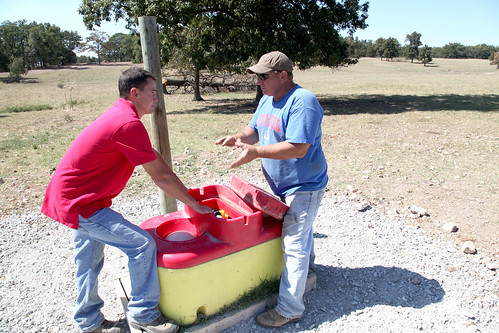
The hot, dry Arkansas summer last year affected cattle farmers across Arkansas. But thanks to USDA’s Natural Resources Conservation Service (NRCS) and the Illinois River Sub-Basin and Eucha-Spavinaw Lake Watershed Initiative, Craig and Jay Oliphnant’s operation has been able to effectively weather the drought.
The Oliphnants have 60 cows, as well as calves, on 200 acres in Benton County. They received assistance from NRCS to install new watering facilities and implement rotational grazing practices, as well as install underground piping, all of which, they say, saved them from having to sell off all their cattle during the drought. Two of the three ponds on their property dried up from the lack of rain, but with NRCS’ help, the brothers were able to continue watering their cattle and pastures.
The Oliphnants’ new conservation practices are benefiting not just the cows—they are also a plus for the environment. The prescribed grazing system will improve water quality, reduce soil erosion and enhance the quantity and quality of forage. And the nutrient management plan will also help protect water quality, which is the focus of the Illinois River Sub-Basin and Eucha-Spavinaw Lake Watershed Initiative—through which they received assistance from NRCS.
Enhancing the water quality in the watershed is crucial to ensuring an adequate supply of drinking water for Tulsa, Okla., and many smaller communities and in the area.
The Illinois River Sub-Basin and Eucha-Spavinaw Lake Watershed is in northwestern Arkansas and northeastern Oklahoma. Significant water quality problems in this area have been identified by the U.S. Geological Survey, including high concentrations of nitrogen, phosphorus, sediments and bacteria.
Some of the possible causes include runoff after animal manure application (as fertilizer), soil erosion and nutrients from poultry production. There is a high concentration of poultry and livestock farms in the Illinois River Sub-Basin and Eucha-Spavinaw Lake Watershed.
By signing up agricultural operations like the Oliphnants’ to participate in voluntary conservation programs, the Illinois River Sub-Basin and Eucha-Spavinaw Lake Watershed Initiative aims to reduce nutrients, bacteria and sediments in the lakes and streams of the area.
Partners in the Illinois River Sub-Basin and Eucha-Spavinaw Lake Watershed Initiative include local conservation districts, the Arkansas Natural Resources Commission, Oklahoma Conservation Commission and USDA’s Farm Service Agency.
